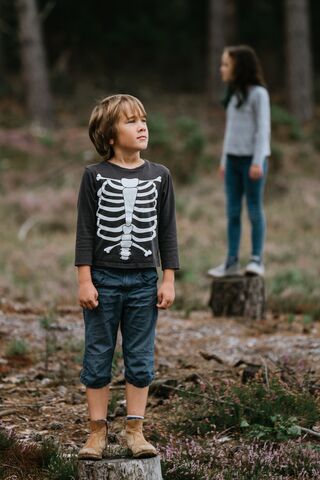Family Dynamics
How Toxic Parenting Can Lead to Sibling Warfare
Understanding why it's more the norm than not.
Posted July 23, 2020 Reviewed by Matt Huston

The most important collateral damage experienced by unloved daughters is rarely discussed: the fraught, fraying, and ultimately hostile or nonexistent sibling ties, especially if a daughter is alone and isolated in her recognition of the family dynamics. In adulthood, these rifts and losses may signal the end of a family history, both for the daughter herself and her children, if she has them. Since our hopes tend to be dominated by images of extended generations at a picnic or holiday, either in photographs or styled in the way Norman Rockwell might, the loss of those dreams may hit us hard.
The truth about siblings is much more complicated than cultural myths suggest. Even in healthy families, there are brothers and sisters who are close and connected but there are also many who aren’t.
Is sibling closeness a myth or just complicated?
Two securely attached siblings are more likely to be close than two insecurely attached siblings, who are much more likely to engage in competition and, yes, rivalry. Among adult siblings, studies show that roughly half speak to or see one another about once a month; that leaves half who communicate less frequently or not at all. But sibling relationships become a tangled web when there’s an unloving mother or father involved, especially one who plays favorites or is high in controlling, combative, or narcissistic traits. The culture idealizes the potential of sibling relationships—but the reality often falls short.
The culture’s insistence that having a sibling is key to individual growth, especially the ability to socialize and make friends, has a darker side, such as the normalization of “sibling rivalry.” This backhanded way of acknowledging the jostling for parental attention that can go on in a family can result in parents’ ignoring or normalizing sibling aggression and bullying. That’s exactly what a study by Corinne Jenkins Tucker and her coauthors revealed, looking at three subtypes of sibling aggression: physical assault, property victimization, and psychological aggression. And yes, there’s an association between sibling aggression and poor mental health outcomes.
In dysfunctional families, the loss of sibling connection or uneasy maintenance of frayed relationships tends to be the norm, rather than the exception; yes, there are some supportive and tight bonds—what experts call “Hansel and Gretel pairs”—but they are few and far between. Sibling connection is a complicated subject because, even though siblings share the same parents, their experiences of them—and their treatment by them—may be very different and, in some cases, so different as to be irreconcilable. Differing views of filial duty, obligation, and loyalty may put adult siblings at loggerheads, especially if one or more adult children will not even brook a discussion about their mother.
Beneath the surface tensions lie discernible patterns. In families with mothers who are combative, controlling, or high in narcissistic traits, not every adult child will appreciate or understand how sibling relationships were scripted and orchestrated by their mothers; they may not see how they were cast into roles that had them act out in certain ways. Some will continue to buy into the family “truth”—that there was one “bad apple” among them responsible for all the family’s ills, for example—without realizing it was nothing more than a justifying mythology based on scapegoating. Because everyone normalizes his or her own childhood experiences, it may be impossible to see how the constant and unfavorable comparison of one sibling to another poisoned the well from the start. Of course, an individual’s role in this particular script matters, too; if you are the favored sib, why would you question what you believe to be an apt comparison, even in adulthood?
In the worst-case scenario, the mother (and sometimes the father) are the master puppeteers who leave behind a legacy that is difficult, if not impossible, to untangle. The unloved daughter’s persistent feeling of not belonging during childhood, of being an outsider looking in, may ironically reappear in another variation when she actually recognizes her mother’s toxicity and begins to address it—only to be greeted by an angry and defensive phalanx of siblings.
How close are siblings in healthy families?
Not as close as the cultural tropes would have you think. In their classic book, The Sibling Bond, Stephen Bank and Michael Kahn explain that what differentiates sibling relationships is the degree of identification one sibling has with the other. At one end of the spectrum is close identification. While this sounds ideal, it actually can be unhealthy, yielding a fused relationship in which selfhood is lost, a merging one in which one sibling is unsure of who he or she is, or an idealizing one in which one sibling becomes the lesser hero-worshipper of the other.
In the middle of the continuum is partial identification, which is the healthiest and most flexible of sibling bonds, at least potentially. Here, each sibling appreciates the similarities between them and the differences are respectfully noted, but what matters is the dynamic. If it’s a constructive dynamic. what friction exists is accepted as the normal wear-and-tear of emotional connection. Moreover, their connection is neither exclusive nor excluding, becoming a thread in the larger fabric of emotional connections in life. These siblings are actually friends, choosing to renew their connection not just because of their shared history but also because they actually enjoy each other’s company. As one woman commented, “Who I am isn’t separable from my being one of three. Yes, my siblings sometimes drive me nuts, but being a sister and having a brother and a sister shaped me and continues to even as an adult.” Alas, it’s also not uncommon for siblings to stay connected but interact in a destructive dynamic, always at each other’s throats.
Finally, at the other end of the spectrum is distant identification, in which each sibling feels no similarity but great difference. Absent a feeling of connection, these siblings either live parallel lives or are estranged. As one woman wrote me, “I wouldn’t befriend either of my siblings if I met them today. We dealt with each other while our parents were alive, but now there’s no reason to.” Another woman commented, “Other than sharing the same two people as parents, I honestly think I have more in common with two strangers I share an elevator with than with my brother and sister.”
What determines the nature and quality of a sibling relationship
Lots of different factors, it turns out. While age differences affect siblings more in childhood than in adulthood—being five or six years older is a big deal when one child is 18 and the other 12—they, too, tend to fade away in adulthood; there’s not a lot of difference between 42 and 48. But the roles each child played in the family may mark the relationship indelibly, especially if there was parental favoritism. A big age difference—say, nine or ten years—may have different effects, since it’s likely that each child will be born into a family (and marriage) that has changed or evolved, for better or worse.
Personality matters, too, and sometimes siblings are sufficiently different in both temperament and interests that enjoying each other’s company is difficult. When this happens in a healthy family, there’s mutual respect rather than intimacy and friendship in childhood. That may change or not later in life when siblings may discover they have more (or less) in common than they thought, but there’s no enmity. In an unhealthy family, when there’s manipulation of those differences by a mother or father, the outcome is quite different. That was the story Leslie told:
“My sister looks and acts like my mother—a blond, petite fashionista. She could care less about academics and has never bothered to inform herself about anything, even as an adult. I was the bookish one my mother and sister mocked. They called me ‘the ugly duckling’ and said things like ‘Poor Leslie. No one will ever ask her out on a date.’ My sister was relentlessly cruel and followed our mother’s lead. I don’t see her unless I’m forced to.”
Do what you can to see the topography of your sibling relationship(s) as objectively as you can, using cool processing. Understanding the overall family dynamic into which all of you were thrust is important, as is acknowledging individual differences, including your own. Think about personalities, too, and how some differences or clashes were perhaps inevitable. Understanding how you connect to your siblings today can only be achieved by truly seeing what happened then and since.
This post is adapted from my book, The Daughter Detox Question and Answer Book: A GPS for Navigating Out of a Toxic Childhood.
Copyright © 2019, 2020 by Peg Streep. All rights reserved.
Facebook image: Lapina/Shutterstock
References
Bank, Stephen P., and Michael D. Kahn. The Sibling Bond. New York: Basic Books, 1997.
Boer, Frits, Arnold Goedhart, and Philip Treffers. “Siblings and Their Parents.” In Children’s Sibling Relationships: Developmental and Clinical Issues, Frits Boer and Judy Dunn, eds. Hillside, N.J.: Lawrence Erlbaum Associates, 1992.
Jensen, Alexander C., Shawn D. Whiteman, Karen L. Fingerman, and Kira S. Birditt. “‘Life Still Isn’t Fair’: Parental Differential Treatment of Young Adult Siblings.” Journal of Marriage and Family, 2013, vol. 75(2), pp. 438-452.
Rauer, Amy J., and Brenda L. Volling. “Differential Parenting and Sibling Jealousy: Developmental Correlates of Young Adults’ Romantic Relationships.” Personal Relationships, 2007, vol. 14(4), pp. 495-511.
Tucker, Corinna Jenkins, David Finkelhor, Heather Turner, and Anne Shattuck. “Association of Sibling Aggression with Child and Adolescent Mental Health.” Pediatrics, 2013, vol. 132(1), pp. 79-84.
Waldinger, Robert J., George E. Vaillant, and John Orav. “Childhood Sibling Relationships as a Predictor of Major Depression in Adulthood: A 30-Year Prospective Study.” The American Journal of Psychiatry, 2007, vol. 164(6), pp. 949-954.




